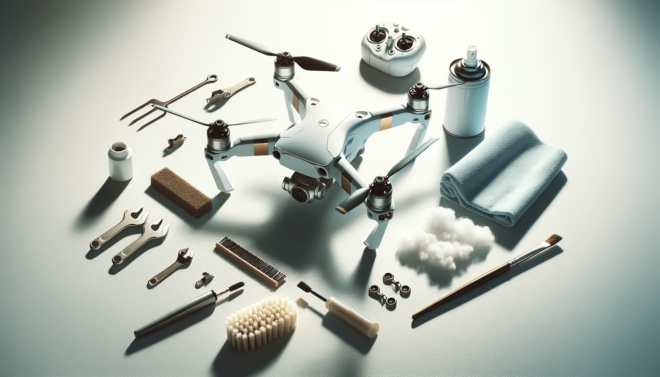How Do I Perform Basic Maintenance On My Drone?
You’ve invested in a drone, and now you want to make sure it stays in top condition. Proper maintenance is key to keeping your drone flying smoothly and safely. In this guide, we will walk you through the steps of performing basic maintenance on your drone. Let’s get started!
Checking for Damage
The first step in maintaining your drone is to check for any damage. This includes inspecting the body, propellers, and any other critical components for cracks, dents, or signs of wear and tear.
Don’t forget to check the motor arms for any signs of damage, as well as the landing gear and the camera (if your drone is equipped with one).
If you notice any damage, it’s crucial to address it before flying your drone again.
Cleaning Your Drone
Dirt, dust, and debris can accumulate on your drone over time, affecting its performance and potentially causing damage. Regularly cleaning your drone will not only keep it looking great but also help maintain its functionality.
To clean your drone, use a soft cloth or a small brush to remove any debris from the body and propellers. Be gentle to avoid damaging any delicate components.
You can also use a can of compressed air to blow away dust from hard-to-reach areas, such as the motor arms and the camera lens.
Calibrating Your Drone
Drone calibration is essential for ensuring stable flight and accurate control. Most drones come with an easy-to-use calibration tool that guides you through the process.
Before calibrating your drone, make sure you are in an open area with plenty of space to move around. Follow the instructions provided by the manufacturer to calibrate the drone properly.
After calibration, test your drone in a controlled environment to ensure everything is working correctly before taking it for a flight.
Checking and Updating Firmware
Just like any other electronic device, drones require regular firmware updates to maintain optimal performance and stay up to date with the latest features and improvements.
Check the manufacturer’s website or app for any available firmware updates for your drone. Follow the instructions to download and install the updates onto your drone.
Firmware updates typically address bugs, enhance stability, and introduce new features, so it’s essential to keep your drone’s firmware up to date.
Battery Care
The battery is a vital component of your drone, providing the power needed to keep it airborne. Proper battery care is crucial for maintaining the overall health of your drone.
Always follow the manufacturer’s instructions for charging and discharging the battery. Avoid overcharging the battery or letting it run completely out of power.
Inspect the battery regularly for any signs of swelling, leaks, or damage. If you notice any issues, replace the battery immediately to avoid any potential safety hazards.
Storage and Transportation
Proper storage and transportation are essential for protecting your drone from damage and maintaining its functionality.
When not in use, store your drone in a cool, dry place away from direct sunlight and moisture. Use a carrying case or a protective bag to transport your drone safely.
Avoid leaving your drone exposed to extreme temperatures, as this can affect the performance of the battery and other components.
Propeller Maintenance
Propellers are crucial for keeping your drone airborne, so it’s essential to inspect and maintain them regularly.
Check the propellers for any signs of wear, such as cracks, chips, or deformation. Replace damaged propellers immediately to avoid any potential flight issues.
Keep a set of spare propellers on hand so you can quickly replace them if needed. Make sure to follow the manufacturer’s instructions for installing new propellers properly.
Camera Maintenance
If your drone is equipped with a camera, it’s essential to take care of it to ensure high-quality footage and smooth operation.
Clean the camera lens regularly with a soft cloth to remove any dirt or smudges. Avoid using harsh chemicals or abrasive materials that can scratch the lens.
Check the camera settings to ensure they are optimized for the type of footage you want to capture. Experiment with different settings to find the best configuration for your needs.
Troubleshooting Common Issues
Even with regular maintenance, drones can sometimes encounter issues that need troubleshooting. Here are some common problems drone owners may experience:
-
Drifting during flight: Check the calibration of your drone and make sure it is properly calibrated. Adjust the trim settings if necessary to correct any drifting issues.
-
Weak GPS signal: Ensure you are flying your drone in an open area with a clear line of sight to the sky. Avoid flying near tall buildings or structures that may interfere with the GPS signal.
-
Failure to start: Check the battery level and make sure it is fully charged. Inspect the power connections and ensure they are secure. If the issue persists, consult the manufacturer’s troubleshooting guide.
-
Interference with other devices: Keep your drone away from other electronic devices that may interfere with its signal. Fly in an area with minimal Wi-Fi or radio interference to maintain a stable connection.
Regular Inspection Schedule
Creating a regular inspection schedule for your drone can help you stay on top of maintenance tasks and identify any potential issues before they become more significant problems.
Set aside time each month to inspect your drone thoroughly, checking for damage, cleaning the body, propellers, and camera, and calibrating the drone as needed.
By staying proactive with your maintenance routine, you can extend the life of your drone and ensure it continues to perform at its best.
Conclusion
Performing basic maintenance on your drone is crucial for keeping it in top condition and ensuring safe and smooth flights. By following the steps outlined in this guide, you can maintain your drone with confidence and enjoy flying it for years to come. Remember to check for damage, clean your drone regularly, calibrate it as needed, and keep up with firmware updates to maximize its performance. Happy flying!

